The ASUS ROG Strix GL502VS Review: Mainstream GTX 1070 with G-SYNC
by Brett Howse on December 9, 2016 8:00 AM ESTWireless
ASUS outfitted the GL502VS with the Intel Dual Band Wireless-AC 8260 network adapter, and it has been in quite a few notebooks this year. This is easily Intel’s best network adapter yet, combining solid connections with impressive speed. They have an 8265 model which we should be seeing soon, adding the MU-MIMO features they have been missing on previous cards.

The ASUS implementation is very solid, offering transfer rates that can peak well over 600 Mbps, and sustained transfer rates are quite good as well. It doesn’t quite match the 3x3 solution that Dell offers on the XPS 15, but for a 2x2:2 adapter it is easily one of the best out there.
Audio
ASUS has two speakers which fire up towards the user. There are small red speaker grills on the keyboard deck which fit in well with the overall theme of the notebook design.
The speakers get reasonably loud, with measurements of 83 dB(A) while playing back a music track with the SPL meter one inch over the trackpad. The sound quality is not great though, with the typical flat sound of a notebook that struggles to reproduce much of the audible range. As with most notebooks, headphones would be a wise choice, especially with the fan noise.
Thermals
Keeping everything cool in a gaming laptop is clearly a “must have” on anyone’s list. Unlike some burst workloads, gaming sessions can easily span hours. ASUS uses a dual-fan solution which has copper and heat pipes to help move the heat away from the GPU and over to the fans. One design choice which gets in the way slightly though is the display hinge, which causes the bottom of the display to swing behind and cover some of the vent.
Running Dragon Age at maximum settings for an extended period of time shows that the thermal solution is adequate in that the GPU does not thermally throttle under its base clock. In the test, the temperature peaked at 86°C, and the GPU was able to manage about 1550 Mhz.
The chassis did get very warm though, thanks to the display hinge design. With some of the hot exhaust air being blocked, and redirected forward, the top of the laptop got very warm, with an average of around 50°C above the keyboard, with some sections closer to 55°. ASUS is certainly not the only company to do this, but a hinge-forward design like they use on the ASUS G752 would really help here.
The fan noise was high as well, especially under sustained load where it was measuring 51 dB(A) with the SPL meter an inch over the trackpad. This is quite loud and would necessitate headphones for most gaming scenarios. At idle, the fans do run all the time, with a constant 40 dB(A) measured in the same location. The fan pitch is low enough where it is not distracting, but it is certainly audible.
Software
ASUS has a couple of utilities included, with the main one being the ROG Gaming Center. This utility allows you to quickly and easily monitor CPU and GPU frequency and temperature, and adjust things such as disabling the Windows Key.
There are several profiles which you can set up as you like, and the switch to them later to quickly set the laptop to a baseline for a particular task.
The software is pretty simple to use, and effective enough. What it is missing though is the ability to bind macros to the keyboard, which is something that some gamers do use, and it would be nice to see this as an option.
The ROG Gaming Center can also be used to launch into other utilities, such as the ASUS Splendid utility, which is a tool they bring to adjust the display. There are four modes, with normal, vivid, and custom as the typical ones, with custom allowing you to change the display color temperature. The fourth is their Eye Care mode, which eliminates the blue levels, and the amount can be adjusted with a simple slider.
Overall the ASUS GL502VS is fairly light on software, which is a good thing. There is the basic utilities, an install of XSplit Gamecaster, and not much else, which is a welcome change from many devices.


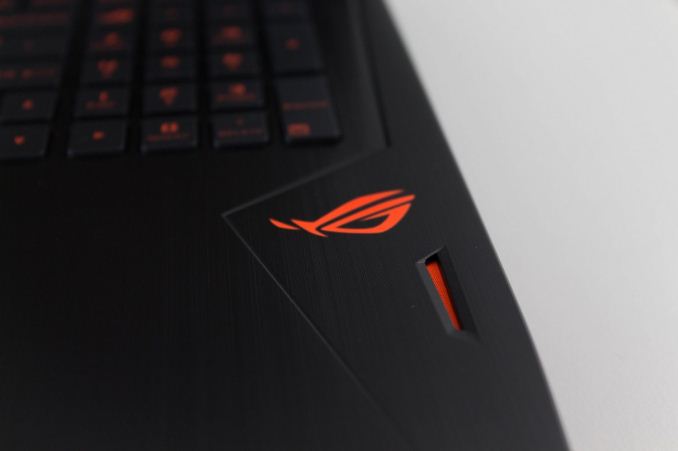
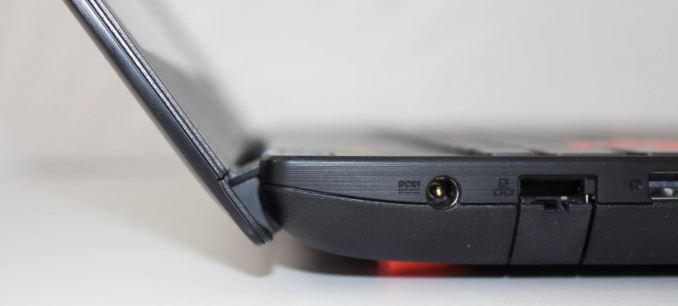
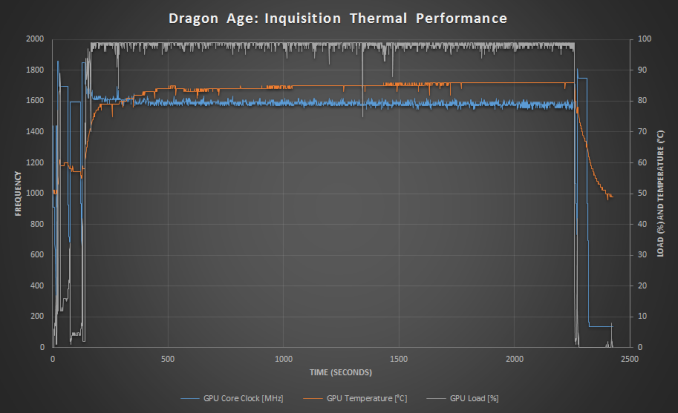
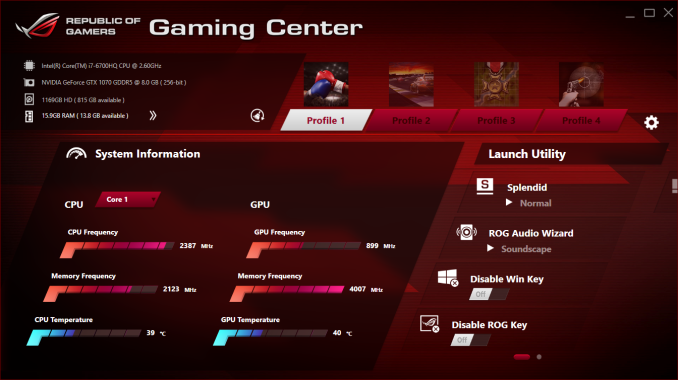

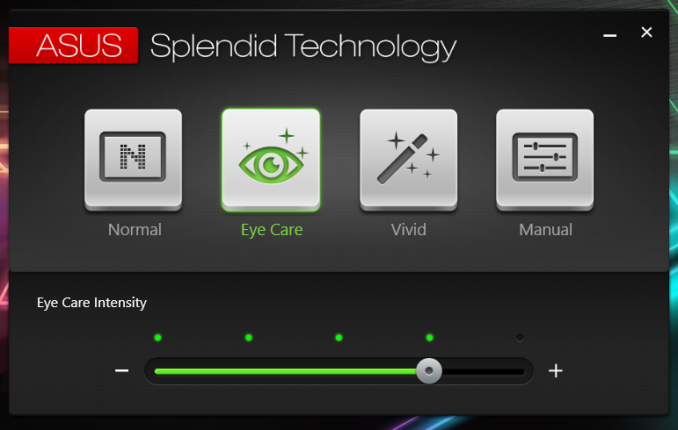








54 Comments
View All Comments
nathanddrews - Friday, December 9, 2016 - link
Is $1600 mainstream?Hopefully we see FreeSync (or G-Sync) laptops on the "low end" $800 laptops. Seems like a ripe market for Adaptive Sync technologies, given the lesser performance of GTX 960m and similar parts.
close - Friday, December 9, 2016 - link
Given the prices I saw recently on deeply flawed (unbalanced) gaming machines, ~$1600 for something that comes with more than decent CPU, GPU and SSD might as well be called mainstream. The rest is still compromised as opposed to a proper gaming machine (small screen, integrated keyboard and touchpad) but at least you get a reasonable package for a relatively reasonable price.Do not compare it to a desktop. The desktop will still be twice as cheap and a lot more powerful for a long time.
xenol - Friday, December 9, 2016 - link
Find me a complete desktop system (that includes all of I/O) that performs about the same for half the cost.sorten - Friday, December 9, 2016 - link
It would be difficult to find a comparable desktop for the comparison. You could probably go with an i5 65W CPU and it would significantly outperform the laptop's 45W i7. The 1070 is the same for desktop and mobile, but much more thermal headroom on the desktop. Memory and SSDs are cheap. I also wouldn't count the cost of the monitor in the comparison, because the only time I wouldn't dock the laptop so I could use my 27" monitor would be in the rare trip to a hotel or similar place.The other thing is that anyone who is building a desktop for gaming is only replacing one or two components. For example, I could build a faster desktop gaming system than this laptop by just spending the $400 on the GPU. I've had the same case, PSU, optical drive, etc. for probably 7 or 8 years.
Samus - Sunday, December 11, 2016 - link
The other thing to keep in mind is you can build a mini ITX system with an i7 and GTX1070 while still being incredibly tiny, less expensive and more capable (aside from being slightly more bulky and lacking battery power.)But that's the real killer with gaming laptops. Unless they are DTR's, they are too weak in graphics performance, and when they are DTR's, battery life is a joke anyway.
close - Tuesday, December 13, 2016 - link
@xenol, if it's any easier for you to understand read it as "performance/$". Or do you specifically want me to lookup some desktop CPUs/GPUs that are gimped by thermal headroom to match the equivalent laptop ones, a case that allows for close to 0 upgradeability, a 15" mediocre screen, crappy keyboard, integrated buzzers... erm, speakers, and a touchpad instead of a mouse?I was talking more of a hypothetical equivalent since it's hard to build a desktop that matches *any* gaming laptop in compromises. Yeah, I get that if you want portability a laptop is the way to go. It's still a severely compromised machine, it's still extremely expensive for the hardware but maybe the difference is how much "portability" costs.
Donny2005UK - Wednesday, January 11, 2017 - link
https://www.amazon.com/Lenovo-Ideacentre-Y700-Desk... Sorry cheapest I could find with a decent cpumrmcmurren - Wednesday, February 1, 2017 - link
hey if you are intested i am selling my desktop with better specs for a great price 1200email me at mrmcmurren@gmail.com
specs as follows
BLUETOOTH: None
CASUPGRADE: None
CD: 24X Double Layer Dual Format DVD+-R/+-RW + CD-R/RW Drive (BLACK COLOR)
CD2: None
COOLANT: Standard Coolant
CPU: Intel(R) Core� i7-3820 Quad-Core 3.60 GHz 10MB Intel Smart Cache LGA2011 (All Venom OC Certified)
CS_FAN: Maximum 120MM Color Case Cooling Fans for your selected case
FA_HDD: None
FAN: Asetek 510LC Liquid Cooling System 120MM Radiator & Fan (Enhanced Cooling Performance + Extreme Silent at 20dBA) (Single Standard 120MM Fan)
FLASHMEDIA: None
GLASSES: None
HDD: 2TB (2TBx1) SATA-III 6.0Gb/s 64MB Cache 7200RPM HDD (Single Drive)
HDD2: None
IEEE_CARD: None
MEMORY: 16GB (4GBx4) DDR3/1866MHz Quad Channel Memory (Corsair Vengeance [Free upgrade from 1600MHz Major Brand])
MONITOR: None
MONITOR2: None
MONITOR3: None
MOTHERBOARD: (3-Way SLI/CrossFireX Support) ASUS P9X79 LE Intel X79 Chipset Quad Channel DDR3 ATX w/ Remote GO!, 7.1 HD Audio, GbLAN, 3 Gen3 PCIe X16, 2 PCIe X1 & 1 PCI
NETWORK: Onboard Gigabit LAN Network
OS: Microsoft(R) Windows 8 Pro (64-bit Edition)
OVERCLOCK: No Overclocking
POWERSUPPLY: 800 Watts - Standard Power Supply - SLI/CrossFireX Ready
SOUND: HIGH DEFINITION ON-BOARD 7.1 AUDIO
SPEAKERS: None
TEMP: None
TUNING: None
TVRC: None
USB: None
USBFLASH: None
USBHD: None
USBX: None
VIDEO: GTX 1070 AMP Mini
JoeyJoJo123 - Friday, December 9, 2016 - link
Desktop PCs are cheaper, and are more serviceable, and you avoid the pitfalls of going with a prebuilt system loaded with adware, or in the worst case with Lenovo's Superfish, blatant malware. However, I think you're overestimating the cost of PC ownership, and assume that a complete PC system with peripherals is _half_ the cost of a gaming laptop.GTX 1070 laptop video cards are very roughly comparable to desktop GTX 1070 performance, and Nvidia's gone a long way to help bridge the gap between mobile and desktop class performance. A balanced GTX 1070 PC build will cost ~$1000, with no peripherals or OS. Add in a basic 1080p monitor, mouse, keyboard, etc. and you're at $1250 or so. So the $1600 laptop isn't a farcry from what PC build enthusiasts would claim.
You pay about a 25% premium, I'd think for the compactness and convenience of a fully ready platform. But given that time is a resource, it's not an unjust cost for people who just want a system to be ready without the hassle of the PC building research, parts acquisition, and assembly.
These days prebuilt systems are cheaper than ever, so the argument that building your own PC saves a lot of money is losing its argument. I still do it as it's a fun hobby for me, but I know it's not for everyone.
xenol - Friday, December 9, 2016 - link
I'm poking fun of the desktop fanboy that every time they say "I can make a desktop build for cheaper!" they seem to fail to remember a laptop is a complete system. I'm all for price comparing, but please, make it as apples to apples as possible.It's like every time someone goes "I can make a $400 PC that can best a PS4" fails to account for the fact a PS4 also comes with a $60 controller and a BD drive. I mean, as a pure gaming machine, maybe. But at the same time, if I wanted something that could replace the PS4 as much as possible, I need that BD drive.
I mean, I didn't buy a PlayStation just to play games. I bought it because it's also a media player.